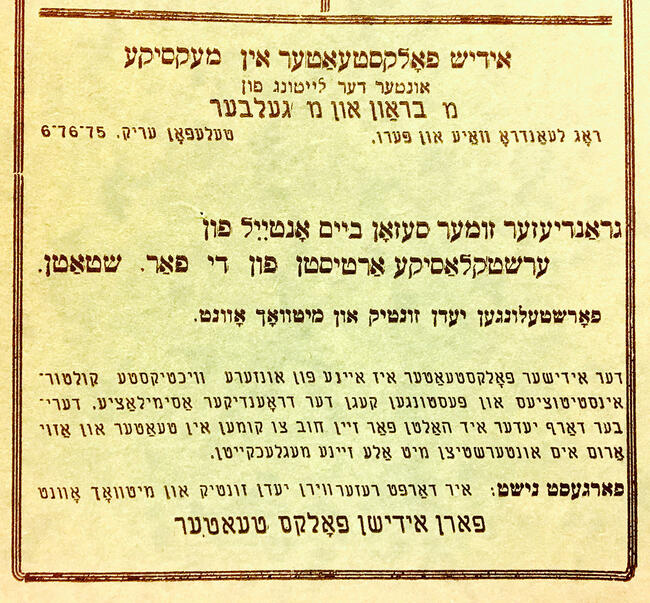A Sampling of Our Yiddish Textbook's Online Supplement
As you can imagine, there’s a physical limit to how many readings and resources we can fit between the covers of a single textbook. In fact, many of the most compelling items in our collections—film clips, videos, audio recordings—that would be useful to students can’t be contained in a printed volume at all.
Our answer is to create a Hesofe: an Online Supplement that will integrate seamlessly with the printed textbook and make audio and video selections and interactive exercises an essential part of every lesson.
How will the Online Supplement be used? The Online Supplement will be chock-full of Yiddish audio and video—most of which our members helped us recover and remaster. Students will be able to listen to excerpts from Yiddish books read aloud at the Jewish Public Library in Montreal or to Montreal lectures by great Yiddish writers such as H. Leyvik, Rokhl Korn, and Kadia Molodowsky. And they’ll be able to watch video clips from our Wexler Oral History Project, as native Yiddish speakers recount riveting moments from their eventful lives.
Below you’ll see a few examples of how the recordings and images will add color and texture to the textbook’s readings.
Sample Lesson: Everyday Routines
“Bertha Kling sings Mani Leyb”
From the Frances Brandt Online Yiddish Audio Library
In this 1955 interview, Yiddish poet Bertha Kling performs a song set to the words of poet Mani Leyb. She then remembers how her home served as a gathering place for Mani Leyb’s group of young New York poets, Di yunge, and describes how he recited this very poem in her living room. Experiencing both the song and the singer's memories, students come to appreciate the work not only for its linguistic and grammatical content, but also for the social context from which it emerged.
In the first part of the activity, learners listen to the song (2:02–3:42 of the clip above), which describes how the singer's sister plants a garden, digs a well, and sews a pillow. Students are then asked to use the structure of the song to write a new verse replacing the verbs with those they’ve learned in their chapter on everyday activities (vashn zikh, washing up; bershtn di hor, brushing one’s hair; etc.).
Then they listen to Kling speak (12:10–13:40 of the clip above), and take notes on words that seem crucial to the story. Using the words they noted down while listening, students are asked to retell the story in pairs.
Sample Lesson: Classroom Objects
“Moyshe Kulbak Taught at My School”
Benjamin Harshav interview, Wexler Oral History Project
In this oral history excerpt, Vilna-born scholar and translator Benjamin Harshav remembers life in Vilna before the War. He recalls how famed Yiddish poet Moyshe Kulbak, a literature teacher at the school where Harshav’s mother served as an administrator, created a classroom exercise. On a snowy day, Kulbak sent one his pupils to purchase a herring. The student returned and handed the herring to the waiting Kulbak who then opened the classroom window and declared to the students, “Here’s snow, here’s herring. Now write.” Harshav shares how this curious juxtaposition of elements was used as a prompt for the students' compositions.
In this activity, learners watch the video (without subtitles!) and figure out what Harshav is saying (using their knowledge of classroom vocabulary acquired in that chapter). They then get the chance to perform Kulbak’s very exercise, using objects and people they see in their own classroom as the materials of inspiration. The combination of text and activity is a remarkable opportunity to hear about a real-life occurrence from prewar Vilna, in the native Yiddish of a person who grew up in that culture—and then to replicate that very occurrence in the classroom of today.
Sample Lesson: City Vocabulary
“Meksikaner shriftn”
Advertisement from 1937, Yiddish Book Center’s periodicals collection
This activity is based on selections from periodicals brought to the Yiddish Book Center as part of a book collection mission to the Yidishe shule in meksike (Jewish School of Mexico). Inside the journals are advertisements for institutions around Mexico City: a furniture store promising that its furniture maximizes “familial happiness,” a youth library ensuring that subscribers will have access to all the greatest recent Yiddish titles, and a Yiddish theater ad that claims it is the reader’s national responsibility as a Jew to attend.
In the chapter on city vocabulary (which presents words such as “store,” “library,” “theater,” etc.), learners do a close reading of the texts to uncover what they say on the surface, and on a deeper level, what they say about the Jewish community in Mexico.

